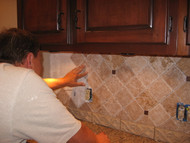How to Install Backsplash Tile Like a Pro: Tips and Tricks
Posted by Mike Belk on May 05, 2024

Introduction to Installing Backsplash Tile
Installing backsplash tile can totally transform your kitchen or bathroom without breaking the bank. But if you've never tackled this project before, the idea might seem a bit daunting. Fear not! We're here to guide you through the process, making it as straightforward and painless as possible. Think of backsplash tiles as a shield for your walls against splashes and stains, plus a major style boost for your space. You'll find tiles in a variety of materials like ceramic, glass, or stone, offering endless design possibilities. Before diving into your project, understanding the basics is key. This includes choosing the right tile, preparing your workspace, and knowing the step-by-step process of installation. With the right tools and a bit of patience, you'll be on your way to adding a personal touch to your kitchen or bathroom that not only looks great but also adds value to your home. Let's embark on this DIY journey together, transforming your space one tile at a time.
Choosing the Right Backsplash Tile for Your Space
Choosing the right backsplash tile for your kitchen or bathroom is crucial. Think about what vibe you're going for. Want something modern? Sleek, glossy tiles might be your jam. Or maybe you're all about that cozy, rustic feel. In that case, consider natural stone or classic subway tiles. Don't just focus on looks though. Think about the grime and the cleanup. Dark tiles hide stains better, but light tiles could brighten up a dim room. Also, material matters. Porcelain and ceramic are easy to clean and maintain, perfect for a busy kitchen. Natural stone like marble adds luxury but demands more care to keep it looking sharp. Size and shape add another layer. Small mosaic tiles add detail but can be a pain to clean. Larger tiles mean fewer grout lines and less scrubbing. Remember, it's not just about picking a tile. It's about creating a space that feels right and works hard for you.
Essential Tools and Materials You'll Need
To tackle a backsplash tile installation project, you don't need a truckload of tools, but the right ones are crucial. First off, get a notched trowel. It's for spreading tile adhesive evenly. You'll also need a tile cutter or wet saw for cutting tiles to fit around outlets and corners. Don't forget a level, to keep your tile lines straight as an arrow. A tile spacer ensures even gaps between tiles, giving you that pro look. Mix your adhesive and grout right with a mixing paddle attached to a drill. Lastly, a grout float helps press the grout firmly between the tiles. Oh, and grab a sponge and bucket for cleanup duty. With these in hand, you're set up for a stellar backsplash job.
Preparing Your Walls for Backsplash Tile Installation
Before you dive into sticking tiles onto your wall, prep work is key. Think of it as laying the groundwork so your tiles stick around for the long haul. First off, make sure the wall is smooth and clean. You want a surface free of dust, grease, and any flaky paint. A quick wipe down with a damp cloth can work wonders. If you spot any holes or cracks, fill them in and sand the area smooth. Don't rush this part; a smooth wall means less hassle later. Next up, check if your wall is even. Using a level, see if there are any dips or bumps. An uneven wall can make tiles look wonky, and you definitely don't want that. If you're working in a kitchen (which is likely), remember to remove any switch plates and outlet covers. Cover everything you don't want tiled with some good old painter's tape. Lastly, think about using a waterproofing sealer, especially if you're tiling around sinks. Water damage is a real mood killer for those beautiful new tiles. With the prep work nailed down, you're setting yourself up for a smoother tiling adventure.
Step-by-Step Guide on Installing Backsplash Tile
First, pick your tiles and gather your tools. You'll need tiles, a notched trowel, tile adhesive, grout, a tile cutter, and a level. Make sure the wall is clean, dry, and smooth. If it’s not, fix it. Next, find the center of the wall. Use a level to draw a straight line vertically and horizontally. This is your starting point. Dry lay the tiles from the center to the edges to check the fit and make necessary cuts in advance. Spread the adhesive with the notched trowel evenly on the wall. Start from the center, place the tiles carefully along the lines, and press them in. Use spacers to keep the tiles evenly apart. Let the adhesive set. It usually takes about 24 hours. Once it's dry, remove the spacers. Time for grout. Mix it as instructed and apply it over the tiles, filling the gaps. Use a grout float to push it in and a damp sponge to wipe off any excess. Let it dry. Finally, apply a silicone sealant around the edges for a waterproof finish. Congratulations, you've just installed a backsplash!
Cutting Tiles: Tips for Precision and Efficiency
Cutting tiles might seem scary, but with the right tips, you'll handle it like a pro. First, get yourself a good tile cutter. This is non-negotiable. It'll make your life easier and your cuts cleaner. Now, mark your tile where you want to cut it. Use a straight edge for accuracy. Once marked, it's time to score the tile. Place the tile in the cutter, apply firm pressure, and push the scoring wheel across the mark once. Now, snap the tile. This step is satisfying – just apply pressure on the tile's scored line, and it should break cleanly along the line. For complex cuts, like around outlets, use a wet saw. Be patient, and feed the tile slowly to avoid chipping. Lastly, always wear safety goggles. Tile shards are sharp and unpredictable. Remember, practice makes perfect. Start with some scrap tiles until you feel confident. Cutting tiles isn't about strength; it's about precision and patience.
Grouting Your Backsplash Tile: Techniques and Advice
After placing your tiles and letting the adhesive set, it's time to grout. Grouting isn't just about filling gaps; it's about sealing your backsplash against moisture and giving it a polished look. First off, choose a grout color that complements your tiles. This can either make your tiles pop or blend them into a seamless whole. You'll need a rubber float to apply the grout. Spread it across the tiles at an angle, pressing firmly to ensure it gets into every space between the tiles. Don't skimp on this; more grout on your float means less time dipping back into the bucket. After applying, give it about 10 minutes, then start wiping off the excess with a damp sponge. Wipe diagonally to avoid digging into the grout lines. Finally, after everything's dry, which might take a day, apply a grout sealer to protect your work from stains and moisture. Remember, speed doesn't trump precision. Take your time to get it right.
Sealing and Finishing: Give Your Backsplash a Professional Look
Finishing your backsplash is like the victory lap in a race—you're almost there, and now it's about sealing that win. Once your tiles are set and the grout has cured, it’s crucial not to skip the sealing step, especially if you've chosen a porous tile like stone. Sealing your backsplash protects it from water, stains, and makes cleaning a breeze. Not all tiles need sealing, but if yours do, simply apply a grout sealer with a small brush directly onto the grout lines. Let it dry according to the product instructions. For a top-notch finish, caulk the bottom edge where your backsplash meets the countertop. This not only looks professional but also prevents water from sneaking behind the tiles. Choose a caulk color that matches your grout for a seamless look. Remember, patience and attention to detail during this phase will elevate your backsplash from good to great.
Maintenance and Cleaning Tips for Your New Backsplash
Keeping your new backsplash looking sharp isn't hard, but it does require regular care. Cleaning it often will keep it bright and prevent damage. Use mild soap and water for basic cleaning. Avoid harsh chemicals or abrasive tools; they can scratch or damage the tiles. For grout lines, a baking soda paste works wonders. Just apply, let it sit for a few minutes, then wipe off. If you have natural stone tiles, seal them once a year to fend off stains. Remember, rapid cleanup of spills, especially acidic substances like tomato sauce or lemon juice, is key. These simple steps will keep your backsplash in tip-top condition, ensuring it remains a highlight of your kitchen for years.
Conclusion: Enjoying Your Newly Installed Backsplash Tile
Now that you've tackled installing your own backsplash tile, take a step back and appreciate your hard work. It's not just about protecting your walls from spills anymore; you've added a personal touch that enhances your kitchen or bathroom's overall look. Remember, the effort you put in pays off not only in the practical benefits but also in the aesthetic appeal you've created. Enjoy your newly installed backsplash tile, knowing you've done a job well done. Every time you walk into the room, you'll get a little reminder of what you can achieve with some patience and effort. So, give yourself a pat on the back. You've earned it.



